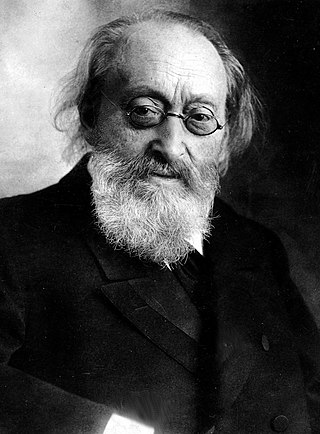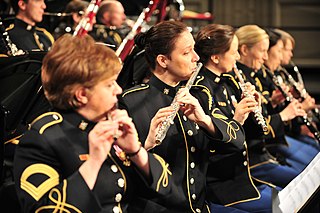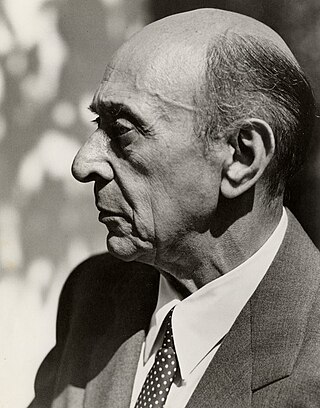Related Research Articles

The Symphony No. 8 in G major, Op. 88, B. 163, is a symphony by Antonín Dvořák, composed in 1889 at Vysoká u Příbramě, Bohemia, on the occasion of his election to the Bohemian Academy of Science, Literature and Arts. Dvořák conducted the premiere in Prague on 2 February 1890. In contrast to other symphonies of both the composer and the period, the music is cheerful and optimistic. It was originally published as Symphony No. 4.
The two Serenades, Op. 11 and 16, represent early efforts by Johannes Brahms to write orchestral music. They both date from after the 1856 death of Robert Schumann when Brahms was residing in Detmold and had access to an orchestra.
Concertino is the diminutive of concerto, thus literally a small or short concerto.
In music, a nonet is a chamber music composition which requires nine musicians for a performance. The standard nonet scoring is for wind quintet, violin, viola, cello, and double bass, though other combinations are also found. Additionally, the term may apply to a group of nine musicians regardless of whether they are playing chamber music.
The Strathclyde Concertos are a series of ten orchestral works by the English composer Sir Peter Maxwell Davies.

Viktor Kalabis was a Czech composer, music editor, musicologist, and husband of harpsichordist Zuzana Růžičková.

The Concerto for Clarinet, Viola, and Orchestra in E minor, Op. 88, is a composition by Max Bruch which was composed in 1911. It premiered on 5 March 1912 in Wilhelmshaven by the piece's dedicatees, violist Willy Hess and the composer's son and clarinet soloist, Max Felix Bruch. The score however was published 23 years after the composer's death, finally being released in 1942.
The Piano Concerto No. 3 is a 32-minute concerto by the Australian-born composer Malcolm Williamson.
In music, a decet—sometimes dectet, decimet, decimette, or even tentet—is a composition that requires ten musicians for a performance, or a musical group that consists of ten people. The corresponding German word is Dezett, the French is dixtuor. Unlike some other musical ensembles such as the string quartet, there is no established or standard set of instruments in a decet.

Carl Nielsen's Wind Quintet, or as indicated by the original score, the Kvintet for Flöte, Obo, Klarinet, Horn og Fagot, Op. 43, was composed early in 1922 in Gothenburg, Sweden, where it was first performed privately at the home of Herman and Lisa Mannheimer on 30 April 1922. The first public performance was on 9 October 1922 in the smaller hall at the Odd Fellows Mansion in Copenhagen. It is considered a staple of the repertoire for wind quintet.
Isidora Žebeljan was a Serbian composer and conductor. She was a professor of composition at the Belgrade Music Academy and a Fellow of the Serbian Academy of Sciences and Arts.
In music, a duodecet—sometimes duodectet, or duodecimette—is a composition which requires twelve musicians for a performance, or a musical group that consists of twelve people. In jazz, such a group of twelve players is sometimes called a "twelvetet". The corresponding German word is Duodezett. The French equivalent form, douzetuor, is virtually unknown. Unlike some other musical ensembles such as the string quartet, there is no established or standard set of instruments in a duodecet.

The woodwind section, which consists of woodwind instruments, is one of the main sections of an orchestra or concert band. Woodwind sections contain instruments given Hornbostel-Sachs classifications of 421 and 422, but exclude 423

The Wind Quintet, Op. 26, is a chamber music composition by Arnold Schoenberg, composed in 1923–24. It is one of the earliest of Schoenberg's compositions to use twelve-tone technique.
Charles Villiers Stanford's Serenade in F major, Op. 95 is a composition for a chamber ensemble of nine soloists, composed in 1905.

The Quinteto is a chamber-music composition by the Brazilian composer Heitor Villa-Lobos, written in 1928. Originally scored for five woodwind instruments, it is most often performed in an arrangement for the conventional wind quintet of flute, oboe, clarinet, horn, and bassoon. A performance lasts about eleven minutes.
The Concerto for String Quartet and Orchestra is a composition for string quartet and orchestra by the American composer Gunther Schuller. The work was composed between 1987 and early 1988. Its world premiere was given on February 20, 1988, by the Pro Arte Quartet and the Madison Symphony Orchestra conducted by Schuller. The piece was a finalist for the 1988 Pulitzer Prize for Music.
Capricorn was a mixed chamber ensemble based in London and active in the 1970s, 1980s and 1990s. Founded by the cellist Timothy Mason, clarinettist Anthony Lamb and pianist Julian Dawson-Lyell, the original lineup was augmented by the violinist Monica Huggett to perform Messiaenʼs Quartet for the End of Time which featured in their London debut concert at Wigmore Hall in January 1974.

The Nonet in E-flat major, Op. 38, is an 1849 composition for chamber ensemble by French composer Louise Farrenc.
References
- Notes
- ↑ Edition Compusic 1988
- 1 2 Cobbett 1930 , p. 208
- 1 2 3 Dibble 1987 , p. 3
- References
- Nonet, Op. 70 for flute, oboe, cor anglais, 2 clarinets, 2 horns and 2 bassoons. Edition Compusic. 1988.
- Cobbett, Walter Willson (1930). Cobbett's cyclopedic survey of chamber music. Vol. 2. Oxford University Press.
- Dibble, Jeremy (1987). Parry & Stanford: Nonets (PDF) (CD). Hyperion Records. CDA66291.